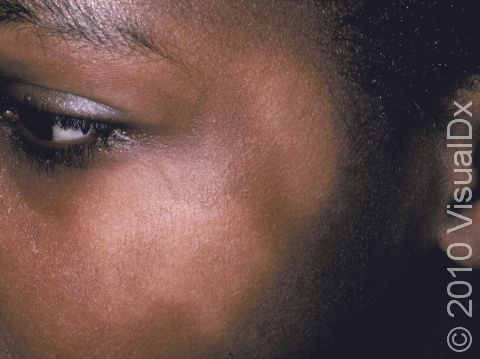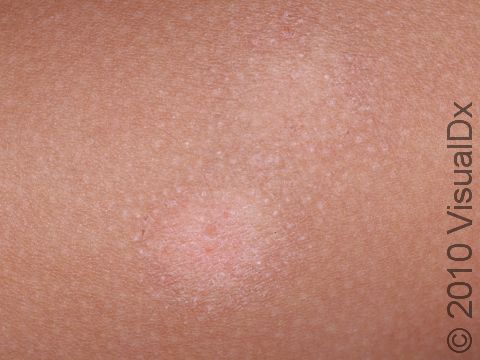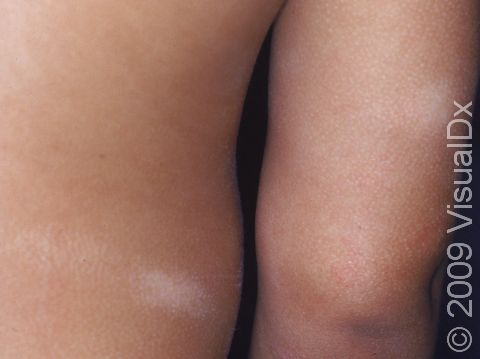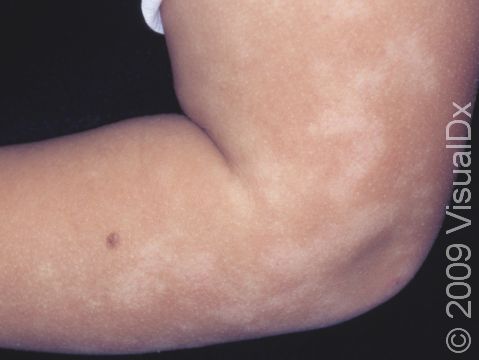Pityriasis Alba
Pityriasis alba is a common skin rash that occurs mainly in school-aged children and less commonly in infants. The rash of pityriasis alba appears as round, light-colored, slightly raised patches that have a thin scale and may be itchy. The lesions are common on the face (cheeks), neck, and upper arms and legs, and may be one half inch to several inches in diameter. The cause of pityriasis alba is not clear, but it appears to be worse with dryness, heat, and other stress to the skin. It does not appear to be contagious. The lesions of pityriasis alba may disappear only to reappear until approximately 1 or more years after the rash began (if left untreated). Once the rash is entirely resolved, normal pigmentation will reappear several months later.
Who's At Risk?
Pityriasis alba is most common in children ages 3–16, although it can be seen in infants, especially those with chronic dry skin or a diagnosis of eczema. Children and infants at higher risk for this condition include those with asthma, hay fever, eczema, and dry skin.
Signs & Symptoms
The most common locations for pityriasis alba include:
- Cheeks, around the mouth, and chin
- Forehead
- Neck
- Shoulders, upper chest, and upper arms
Pityriasis alba appears as several (2–20) light-colored (hypopigmented) patches ranging in size from 1–4 cm. The patches may have slight and subtle surface patches (scale). Occasionally, the condition begins as mildly itchy, pink patches that develop into hypopigmented patches.
People often think that pityriasis alba gets worse in the summer, but it just becomes more obvious as the normal, surrounding skin becomes darker with sun exposure.
Self-Care Guidelines
If you suspect that your child has pityriasis alba, the most important self-care measure is to keep the skin well moisturized. Try the following:
- Use non-soap cleansers or moisturizing soaps.
- Apply moisturizers such as petroleum jelly (Vaseline®) or fragrance-free ointments and creams.
- Avoid sun exposure and wear sunscreen.
- Apply over-the-counter hydrocortisone cream sparingly for 3–7 days.
Treatments
To make sure that there is no yeast or fungus present, your physician may wish to scrape some of the scales onto a slide and examine them under a microscope. This procedure, called a KOH (potassium hydroxide) preparation, allows the doctor to look for tell-tale signs of yeast infection. Pityriasis alba is not caused by an infection with yeast or fungus; therefore, the KOH preparation should be negative.
Since pityriasis alba is benign and does not usually spread or last long, no treatment may be necessary. The physician will recommend many of the self-care measures listed above. In very severe, widespread infections with pityriasis alba, the doctor may recommend:
- Prescription-strength corticosteroid (cortisone) cream
- Ultraviolet light therapy
Visit Urgency
Call your child’s doctor for evaluation if the condition does not improve with self-care measures, if it seems to be getting worse, or if it spreads to other areas.
References
Bolognia, Jean L., ed. Dermatology, pp.223-224, 965. New York: Mosby, 2003.
Freedberg, Irwin M., ed. Fitzpatrick’s Dermatology in General Medicine. 6th ed. pp.837-838, 858. New York: McGraw-Hill, 2003.
Last modified on August 16th, 2022 at 2:44 pm

Not sure what to look for?
Try our new Rash and Skin Condition Finder



